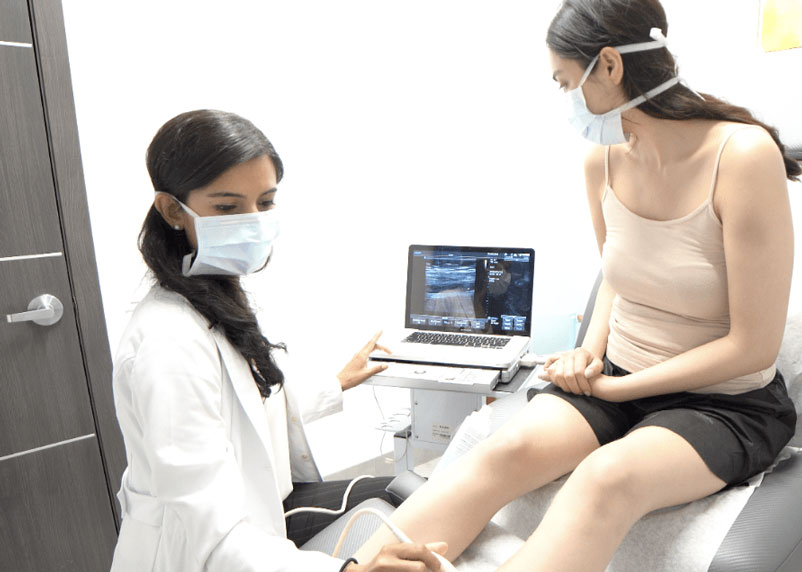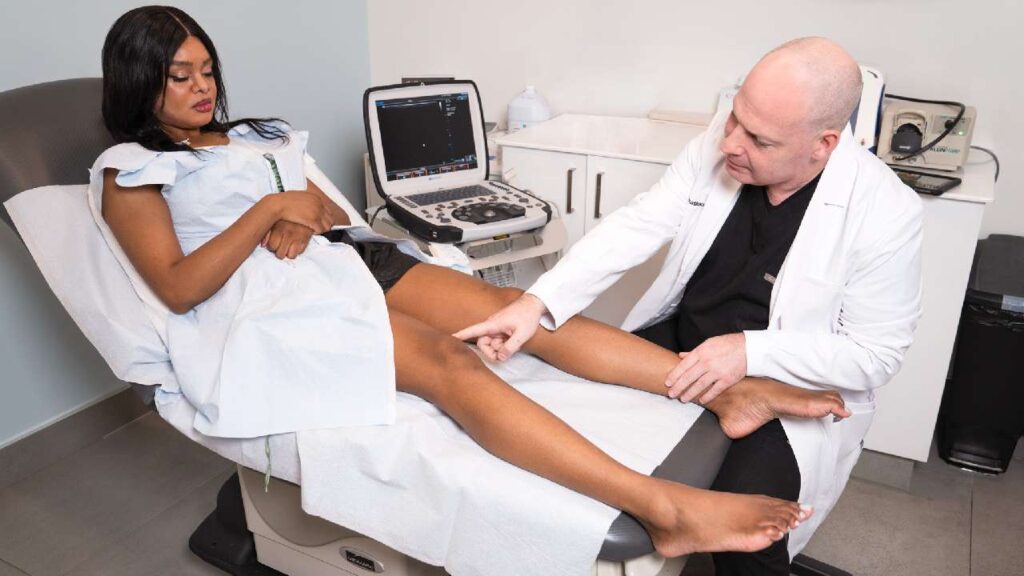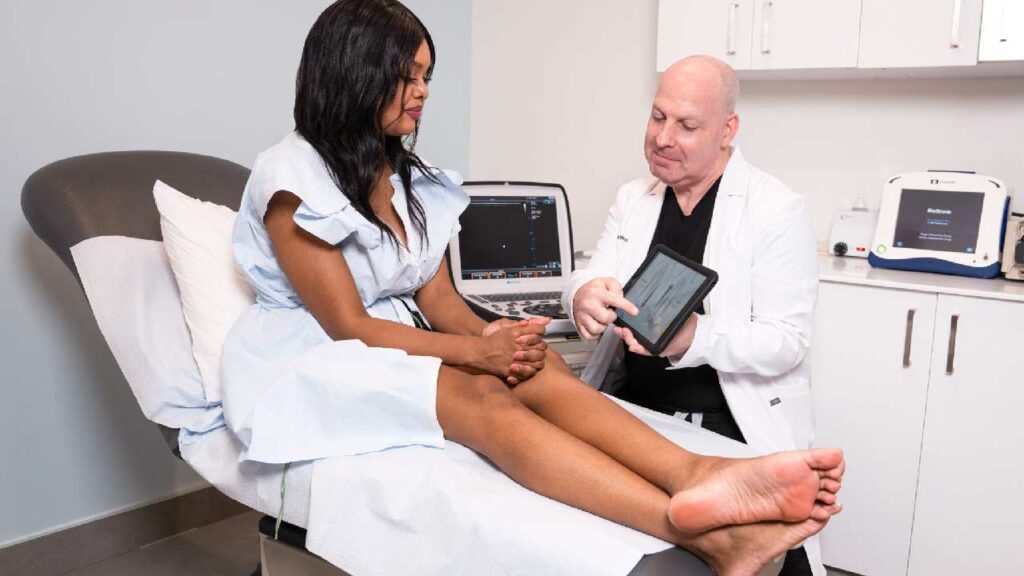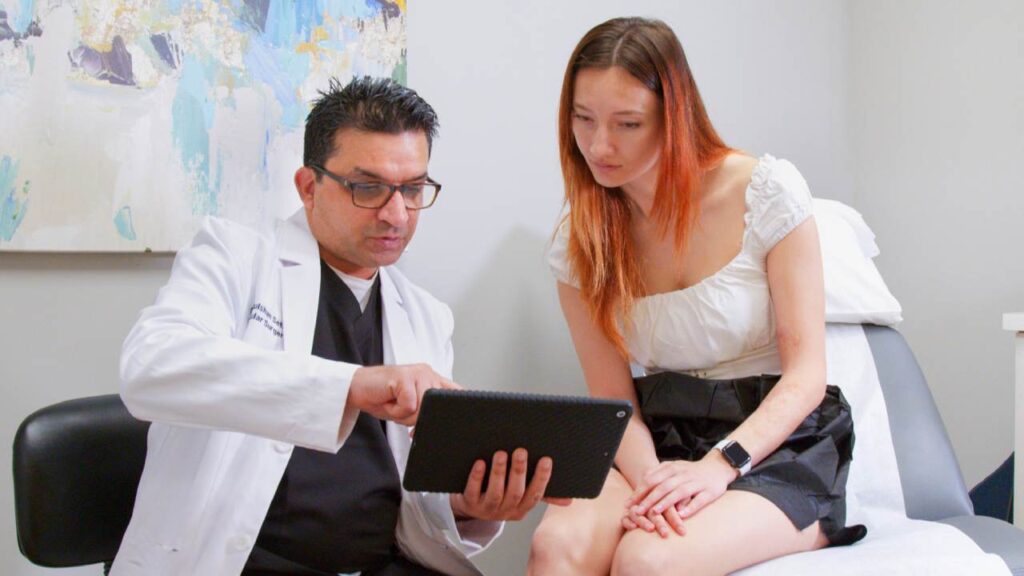Is Vascular Surgery the Right Varicose Veins Treatment?
In previous generations, varicose veins were often treated with a vein stripping surgery, called phlebectomy, to remove the vein. Today, most varicose veins do not require surgery, since minimally invasive alternatives like sclerotherapy, radiofrequency ablation, and vein adhesives can treat veins within the body, sealing them off to reroute blood into healthier veins. If you’ve been postponing a vein consultation because you want to avoid surgery, click HERE to meet with our Harvard-trained, minimally invasive vein specialists and discuss gentler options.

What Can Get Rid of Varicose Veins Besides Surgery?
There are several new techniques for treating veins non-surgically. Minimally invasive options became widely available three decades ago, and are now the primary method for treating spider veins and varicose veins. These procedures use tiny needles, catheters, or fibers, inserted through the skin, to treat the vein directly rather than cutting the vein out of the body. These tactics reduce the risks associated with surgery, and also allow the patient to remain awake during the procedure and retain their mobility immediately after treatment.
Minimally invasive spider veins and varicose veins treatments typically take 15-30 minutes, so patients are able to squeeze in vein care during a lunch break or between their errands. There are no large incisions, stitches, or scars to deal with, and there is minimal wound care involved- most patients can bathe or shower soon after treatment. Patients can even resume moderate exercise right away. In fact, walking is encouraged after endovenous vein treatments to enhance circulation.
Is There a Gentler Varicose Veins & Spider Veins Treatment?
Our NY vein treatment clinics offer several ways to treat varicose veins and spider veins non-surgically. These include sclerotherapy, endovenous laser treatment, radiofrequency ablation, vein adhesives, and mechanochemical ablation. These products are manufactured by various companies, but look for names like Varithena, ClariVein, VenaSeal, VNUS ClosureFast, or Venefit at your vein doctor’s office.
In addition, some vein doctors are now trained to perform ambulatory phlebectomy, which is a gentler way to remove veins if they can’t be treated through the skin. It does not require general anesthesia, and it uses punctures, rather than wide incisions, so it’s faster and less risk-prone than traditional phlebectomy. Certain patients with highly enlarged and tortuous veins or a history of blood clots, particularly those who don’t have vein disease, might be good candidates for ambulatory phlebectomy.
Is Varicose & Spider Vein Removal by Sclerotherapy Surgical?
Sclerotherapy and other minimally invasive procedures are not surgical and are not technically vein “removal.” Instead, they treat veins within the body, causing them to close and become scar tissue that’s harmlessly absorbed by the body. Blood then travels into veins that can pump it back to the heart. The procedures that surgically remove a varicose vein are known as phlebectomy and ambulatory phlebectomy (vein stripping and ligation) and are not required for the majority of patients. Spider veins are almost never treated with surgery.
Do All Veins Popping Out on Legs Need Surgery?
No, most veins popping out on the legs do not require traditional vein surgery. Our NY vein doctors will examine your symptoms, medical history, and venous pathways to determine the best course of action. Most patients respond best to sclerotherapy, radiofrequency ablation, vein adhesives, mechanochemical ablation, or in certain cases, ambulatory phlebectomy. Our experts can also combine treatment modalities if needed to generate the desired results. Some patients inquire about home treatments for varicose veins, like compression stockings, but since bulging veins typically involve valve failure in a deep vein, home remedies cannot repair that and can only help reduce certain symptoms.
Should You Treat Spider Veins in Pregnancy?
Blood volume increases during pregnancy, which can stretch venous walls. In some cases, this leads to spider veins (tiny offshoots of overburdened veins) or varicose veins (enlarged, twisted veins resulting from excess pressure). In other cases, the veins are simply enlarged during pregnancy and shrink in size after delivery. If you develop new or enlarged veins while pregnant, see our vein doctors to determine whether they require treatment. We can assess whether these are unhealthy veins, or simply veins that are temporarily expanding to hold more volume. If you need treatment for varicose veins, we’ll wait until after delivery to ensure the highest level of safety for you and your baby.
Do All Broken Capillaries on Legs Require Treatment?
Blood vessels have three main categories: arteries, capillaries, and veins. Arteries pump blood away from the heart to deliver oxygen and nutrients throughout the body. Capillaries help transfer blood to the veins, after it is deoxygenated. Veins pump it back to the heart to collect more oxygen. Since leg veins must pump against gravity to complete the process, they are prone to weakened vein valves and walls that contribute to a disease called Chronic Venous Insufficiency. Vein damage resulting from Chronic Venous Insufficiency often requires treatment, not only to repair the vein, but also to address the underlying disease and prevent future vein damage.
Capillaries, however, are smaller and do not have valves. Instead, they diffuse blood through their thin walls. Capillaries “break” (or technically, they overdilate) for numerous reasons, including sun damage, skin injury, dehydration, extreme temperatures, diseases, and chemical irritants. Some will heal on their own. Others require laser treatment or sclerotherapy, depending on their location. In many cases, treating capillaries is optional and done for cosmetic reasons, unlike treating varicose veins which can produce significant pain and discomfort, troubling skin symptoms, and impaired circulation if left untreated.
Which Is the Best Clinic for Varicose Veins in NY?
The best clinic for varicose veins in New York is one that provides a wide range of minimally invasive treatment options, performed by board certified vein doctors. Unfortunately, there are several clinics offering vein treatments that are not run by actual vein doctors, and that do not offer the type of treatment required for lasting results. If you have Chronic Venous Insufficiency, treating the surface veins is only a temporary solution, since valve failure will continually produce more telangiectasias and varicosities until it’s addressed.
In addition, topical lasers and certain procedures offered at dermatology and plastic surgery clinics can’t treat large varicose veins or vein diseases. Since it’s impossible for patients to see deep veins and identify the root of the issue, it’s essential to choose vein specialists equipped with technology like duplex ultrasound devices that view all of your venous pathways. Choose our Harvard-trained NY vein doctors for comprehensive spider and varicose vein treatments that identify the source of the problem.
Do You Need a Vein Treatment Clinic or a Leg Vein Clinic?
If you’re researching how to get rid of varicose veins on the legs, you might be curious whether they require the same type of vein clinic as spider veins on the face. The answer depends on the type of specialist and technology employed by the clinic. Damaged leg veins typically stem from valve failure, whereas facial spider veins can develop from things like squeezing a pimple, so treatment varies. However, both varicose and spider veins are often caused by Chronic Venous Insufficiency, a common, yet underdiagnosed, condition that will continue to impair circulation until it is treated.
In addition, spider veins and varicose veins run in families, so if you have one type, you’re more likely to develop the other. So, your best solution is to choose a board certified vein specialist who treats all types of vein damage. Our experts will always explain whether treatment is necessary and will offer the gentlest solution possible. Avoid cosmetic vein clinics that only perform elective, surface treatments, and choose a medical vein treatment clinic where solutions are covered by insurance and proven to last.
Varicose Veins Stages: When Should You See a Vein Doctor?
Like most medical conditions, the earlier you treat varicose veins, the better the outcome. This is particularly true if vein disease is causing your vein damage, since it can produce additional defective veins. There is no universal set of varicose veins stages; symptoms and progression vary between patients.
For some, the veins are asymptomatic, while others develop heaviness, cramping, restlessness, swelling, pain, and discomfort, or frustrating symptoms like venous ulcerations, hyperpigmentation, or profuse bleeding with skin abrasions. In order to avoid unnecessary complications, visit a vein doctor promptly. Our caring team will specify whether treatment is necessary or optional, and will always avoid surgery when possible. We look forward to resolving your venous issues!





